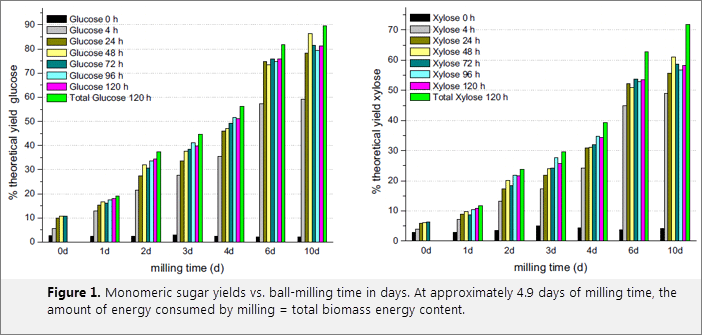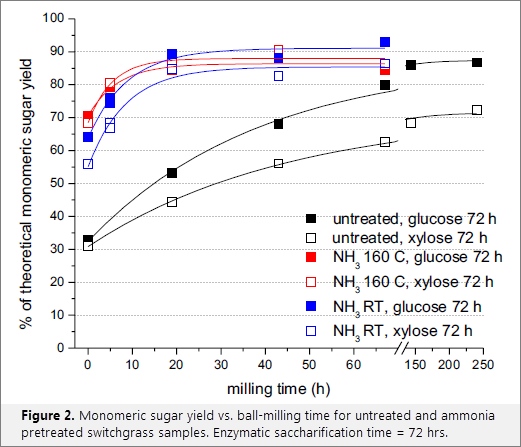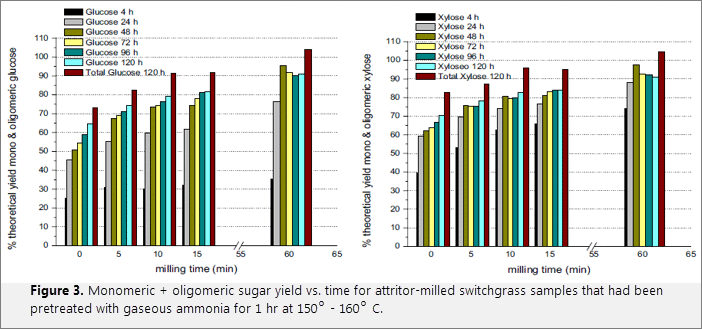Origin Used in Energy Research at DuPont Central Research
Problem
Conversion of lignocellulosic biomass to ethanol has the potential to meet a significant portion of US transportation energy needs. Yet, the energy inputs required for conversion remain a significant barrier to commercial success. On a recent project, Diner and his associates at DuPont Central Research (CR&D) studied various pretreatment and milling options using switchgrass, a native, warm-season perennial grass that yields well in low-input systems. The goal was to identify treatments with the highest energy return.
Solution
Perform curve-fitting on enzymatic saccharification data resulting from the various pretreatments, to extract exponential rate constants. Plotting of sugar yields as a function of milling time was facilitated by incorporating axis breaks into the time axis scale.
“I have been using Origin since approximately 2004 … I learned about Origin from a colleague with whom I was collaborating at the time.”
Bruce A. Diner worked as a research scientist for DuPont for more than 28 years. He recently retired as a Senior Research Fellow with DuPont’s Industrial Biosciences division. Says Diner: “I have been using Origin since approximately 2004. There were definitely others in DuPont Central Research who were using Origin. In fact, I learned about Origin from a colleague with whom I was collaborating at the time.”
Diner has since found Origin to be an essential tool for research and publication: “I have used Origin for a broad range of research projects … to generate figures in published work that I have done on electron transport in photosynthesis, electronic properties of carbon nanotubes, cellulosic ethanol, and microbial metabolic engineering. The figures have included kinetic plots (curve fitting and extraction of kinetic constants), and plotting of spectra of chromatographic traces.”
“In manuscript and presentation proofing, I have also benefited from the ability to click on a figure in a Microsoft Word or PowerPoint file, automatically open the Origin file, make corrections and then export the corrected figure back to the Word or PowerPoint file.”
Recently, Diner published work on a project that looked at converting lignocellulosic biomass to ethanol. Lignocellulosic materials are widely available in the forms of agricultural and forest products waste and as plantings grown specifically for their potential to produce high acreage yields with few inputs. It is believed that the conversion of these materials to ethanol could meet a significant portion of US transportation energy needs. Yet, the energy inputs required for conversion remain a significant barrier to commercial success.
Diner and his associates at DuPont Central Research studied various pretreatment and milling options using switchgrass, a fast-growing, warm-season perennial grass native to North America. The group found that while milling alone can produce a product that yields a high percentage of total sugars upon enzymatic saccharification, the energy consumed in the milling process can be more than twice the energy content of the feedstock. Diner and his associates calculated that the “break even” point would be reached after 4.9 days of ball milling, a period of time roughly corresponding with a theoretical yield of just 60% of monomeric glucose and of 42% of monomeric xylose, after 72 hours of enzymatic saccharification (Figure 1).
“I have used Origin for a broad range of research projects … to generate figures in published work that I have done on electron transport in photosynthesis, electronic properties of carbon nanotubes, cellulosic ethanol, and microbial metabolic engineering.”

Thus, Diner and his associates sought to identify treatments for such lignocellulosic materials that would minimize the energy inputs needed to produce high sugar yields upon enzymatic saccharification. Figure 2, below, compares ball milling times vs sugar yield for switchgrass samples that had been knife milled to 1mm and pretreated with 10wt% gaseous ammonia at 160°C for one hour then ball milled (red squares); hammer milled to 1mm and pretreated with 20wt% gaseous ammonia at room temperature for 9 days, knife milled to 1mm then ball milled (blue squares); and similarly knife milled then ball milled but otherwise untreated samples (black squares). All samples underwent enzymatic saccharification for 72 hours and the results were fitted to an exponential function using Origin's nonlinear least-squares fitter (NLFit). The plot of fit results shows that gaseous ammonia pretreatment greatly increases sugar yield with reduced milling time and energy.

Another phase of the study looked at attritor milling as an alternative to ball milling. Attritor milling has been shown to use half of the energy of conventional ball milling in other applications. Diner and his associates found that 5 minutes of attritor milling produced similar sugar yields as 10 to 20 hours of ball milling. In terms of energy used, the attritor mill consumed 0.958 MJ/kg of biomass over a 5 minute period as compared to 1.397 to 2.794 MJ/kg of biomass, over 10 to 20 hours for conventional ball milling.
The following figure (Figure 3) shows sugar yield at attritor milling times of 0, 5, 10, 15 and 60 minutes. Samples were pretreated with gaseous ammonia for 1 hour at 150° - 160°C, then saccharified in the presence of an enzyme for periods ranging from 4 hours – 120 hours. The full study "Gaseous ammonia pretreatment lowers the required energy input for fine milling-enhanced enzymatic saccharification of switchgrass". 2015. Bruce A. Diner, Jelena Lasio, Carl E. Camp, H. David Rosenfeld, Janine Fan and Bradley C. Fox can be read online and downloaded (PDF) at the open-access journal Biotechnology for Biofuels.
